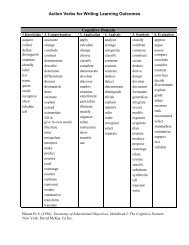ITF - UTSA Provost Home - The University of Texas at San Antonio
ITF - UTSA Provost Home - The University of Texas at San Antonio
ITF - UTSA Provost Home - The University of Texas at San Antonio
You also want an ePaper? Increase the reach of your titles
YUMPU automatically turns print PDFs into web optimized ePapers that Google loves.
<strong>ITF</strong> Evalu<strong>at</strong>ion Study, 2010 10<strong>The</strong> expansion <strong>of</strong> a scholar’s worldview rests on his or her ability to examine self,understand others, and demonstr<strong>at</strong>e pr<strong>of</strong>icient interpersonal skills. Deardorff (2004) focuses onthis issue through the demonstr<strong>at</strong>ion <strong>of</strong> a pyramid model <strong>of</strong> intercultural competence, wherebyone’s <strong>at</strong>titudes, knowledge, and skills are consistently processed to learn more about one’s selfin rel<strong>at</strong>ion to others. Requisite <strong>at</strong>titudes involve the scholar’s appreci<strong>at</strong>ion and respect fordiverse groups, as well as his or her willingness to learn from others. Awareness <strong>of</strong> one’spersonal <strong>at</strong>titudes and beliefs and their impact on the cross-cultural dynamic constitutes theknowledge and comprehension level <strong>of</strong> the pyramid. Also important here is an understanding<strong>of</strong> the salience <strong>of</strong> one’s various cultural identities, such as n<strong>at</strong>ionality, religious orient<strong>at</strong>ion,language, and family characteristics. Lastly, scholars must be willing to consistently analyze,interpret, and re-evalu<strong>at</strong>e their cross–cultural interactions. Such competencies can lead to rich,complex, and insightful learning and teaching outcomes th<strong>at</strong> are characteristic <strong>of</strong> theintern<strong>at</strong>ional scholar experience (Deardorff, 2004; Green & Shoenberg, 2006).Study abroadStudy abroad can be defined in many ways; however, we define it as any opportunity fora student to learn formally in an intern<strong>at</strong>ional locale. This may be in a short or long termprogram, be led by faculty <strong>at</strong> the students’ home institution or by instructors in theintern<strong>at</strong>ional setting, be unil<strong>at</strong>eral or bil<strong>at</strong>eral, and be <strong>of</strong>fered within one or more fields <strong>of</strong>study. <strong>The</strong>se programs are typically focused on the humanities and social sciences, but areincreasing in fields <strong>of</strong> study including architecture, engineering, political science, business, andthe sciences (Dekaney, 2008). Ultim<strong>at</strong>ely, study abroad programs can provide students anopportunity to learn about global diversity and the interdependence and interrel<strong>at</strong>ionships <strong>of</strong>local, n<strong>at</strong>ional, and intern<strong>at</strong>ional issues affecting the world’s popul<strong>at</strong>ion today. <strong>The</strong>seexperiences are <strong>of</strong>ten significantly transforming for students and faculty alike and can be animportant vehicle for <strong>at</strong>taining institutional intern<strong>at</strong>ionaliz<strong>at</strong>ion goals.However, good intentions do not always produce the kind <strong>of</strong> learning, development,and transform<strong>at</strong>ion th<strong>at</strong> is intended (Gray, Murdock, & Stebbins, 2002; Green, 2007). Wu(2006) found th<strong>at</strong> intern<strong>at</strong>ional students <strong>of</strong>ten need special assistance dealing with languageissues th<strong>at</strong> affect test-taking, academic assignments, and social interaction. Woolf (2007)suggests intern<strong>at</strong>ional field-based teaching has remained essentially st<strong>at</strong>ic and curricula andinstructional practices must be significantly revised to meet new global-diversity learningneeds. In addition, the impact <strong>of</strong> studying abroad is not well documented and <strong>of</strong>ten based uponassumptions made by administr<strong>at</strong>ors and faculty (Dekaney, 2008). Acccordingly, VandeBerg(2007) advises th<strong>at</strong> the increase in study abroad enrollment (over 300% in the past 20 years) isleading governments, institutions, and faculty to focus on the effectiveness <strong>of</strong> teaching andlearning in these programs. He stresses th<strong>at</strong> if study abroad students are to learn effectively,faculty in these programs must intervene before, during and after these experiences to formand support their learning. Green (2007) also recognizes th<strong>at</strong> faculty must develop anintern<strong>at</strong>ionalized mindset to cre<strong>at</strong>e learning th<strong>at</strong> is compar<strong>at</strong>ive, integr<strong>at</strong>ive, interdisciplinary,contextual, and global.



